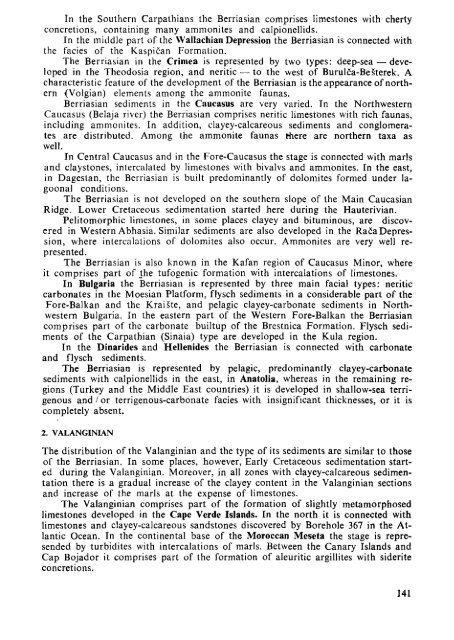THE MEDITERRANEAN LOWER CRETACEOUS
THE MEDITERRANEAN LOWER CRETACEOUS
THE MEDITERRANEAN LOWER CRETACEOUS
You also want an ePaper? Increase the reach of your titles
YUMPU automatically turns print PDFs into web optimized ePapers that Google loves.
In the Southern Carpathians the Berriasian comprises limestones with cherty<br />
concretions, containing many ammonites and calpionellids.<br />
In the middle part of the Wallachian Depression the Berriasian is connected with<br />
the facies of the Kaspican Formation.<br />
The Berriasian in the Crimea is represented by two types: deep-sea — developed<br />
in the Theodosia region, and neritic — to the west of Burulca-Besterek. A<br />
characteristic feature of the development of the Berriasian is the appearance of northern<br />
(Volgian) elements among the ammonite faunas.<br />
Berriasian sediments in the Caucasus are very varied. In the Northwestern<br />
Caucasus (Belaja river) the Berriasian comprises neritic limestones with rich faunas,<br />
including ammonites. In addition, clayey-calcareous sediments and conglomerates<br />
are distributed. Among the ammonite faunas there are northern taxa as<br />
well.<br />
In Central Caucasus and in the Fore-Caucasus the stage is connected with marls<br />
and claystones, intercalated by limestones with bivalvs and ammonites. In the east,<br />
in Dagestan, the Berriasian is built predominantly of dolomites formed under lagoonal<br />
conditions.<br />
The Berriasian is not developed on the southern slope of the Main Caucasian<br />
Ridge. Lower Cretaceous sedimentation started here during the Hauterivian.<br />
Pelitomorphic limestones, in some places clayey and bituminous, are discovered<br />
in Western Abhasia. Similar sediments are also developed in the Raôa Depression,<br />
where intercalations of dolomites also occur. Ammonites are very well represented.<br />
The Berriasian is also known in the Kafan region of Caucasus Minor, where<br />
it comprises part of the tufogenic formation with intercalations of limestones.<br />
In Bulgaria the Berriasian is represented by three main facial types: neritic<br />
carbonates in the Moesian Platform, flysch sediments in a considerable part of the<br />
Fore-Balkan and the Kraiste, and pelagic clayey-carbonate sediments in Northwestern<br />
Bulgaria. In the eastern part of the Western Fore-Balkan the Berriasian<br />
comprises part of the carbonate builtup of the Brestnica Formation. Flysch sediments<br />
of the Carpathian (Sinaia) type are developed in the Kula region.<br />
In the Dinarides and Hellenides the Berriasian is connected with carbonate<br />
and flysch sediments.<br />
The Berriasian is represented by pelagic, predominantly clayey-carbonate<br />
sediments with calpionellids in the east, in Anatolia, whereas in the remaining regions<br />
(Turkey and the Middle East countries) it is developed in shallow-sea terrigenous<br />
and / or terrigenous-carbonate facies with insignificant thicknesses, or it is<br />
completely absent.<br />
2. VALANGINIAN<br />
The distribution of the Valanginian and the type of its sediments are similar to those<br />
of the Berriasian. In some places, however, Early Cretaceous sedimentation started<br />
during the Valanginian. Moreover, in all zones with clayey-calcareous sedimentation<br />
there is a gradual increase of the clayey content in the Valanginian sections<br />
and increase of the marls at the expense of limestones.<br />
The Valanginian comprises part of the formation of slightly metamorphosed<br />
limestones developed in the Cape Verde Islands. In the north it is connected with<br />
limestones and clayey-calcareous sandstones discovered by Borehole 367 in the Atlantic<br />
Ocean. In the continental base of the Moroccan Meseta the stage is represended<br />
by turbidites with intercalations of marls. Between the Canary Islands and<br />
Cap Bojador it comprises part of the formation of aleuritic argillites with siderite<br />
concretions.<br />
141

















